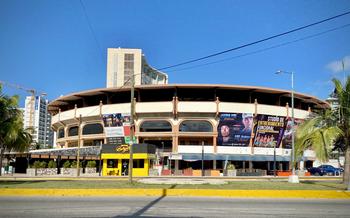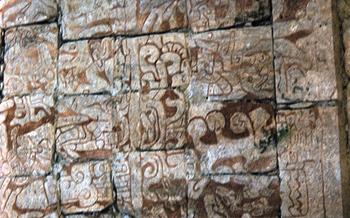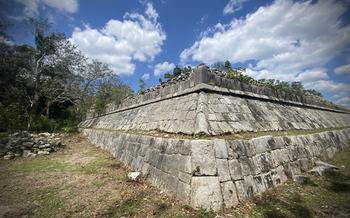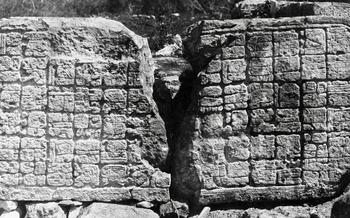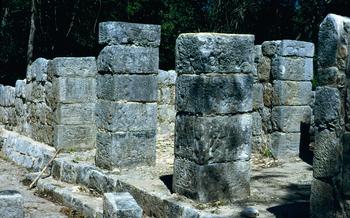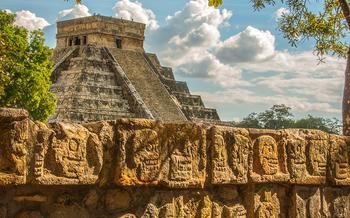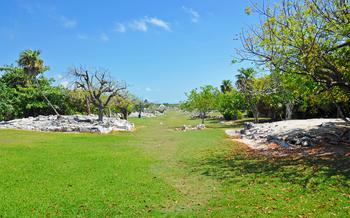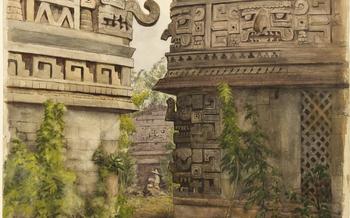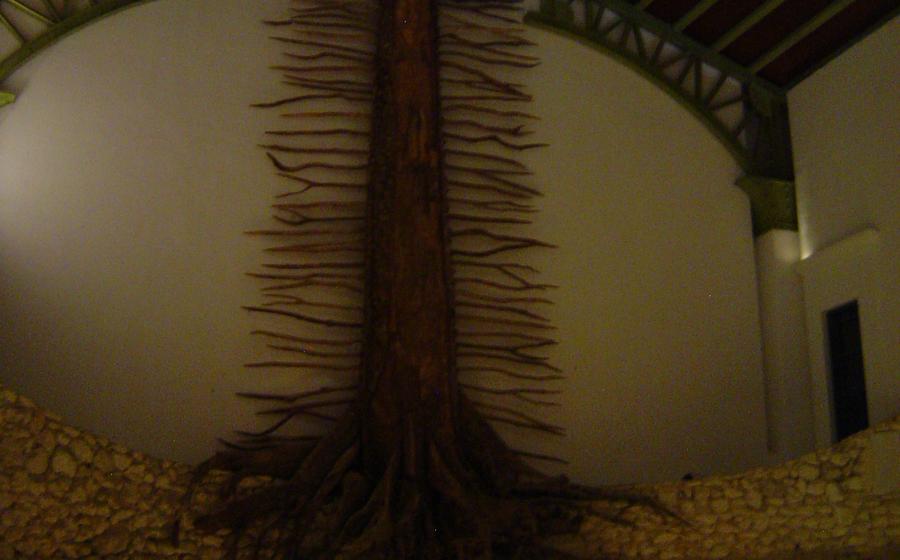
Museo Maya de Cancun
- Xcaret: A paradise in the heart of the Riviera Maya
- Museo Maya de Cancun: A journey through the ancient Mayan civilization
- Exploring the exhibits: A glimpse into Mayan life
- Unveiling the secrets of the Mayan calendar
- Admiring the intricate Mayan art
- Learning about the Mayan writing system
- Witnessing the grandeur of the Mayan architecture
- Discovering the Mayan religious beliefs
- Understanding the Mayan social structure
- Exploring the Mayan Economy
- Experiencing the Mayan cuisine
- Enjoying the Mayan music and dance
- Visiting the Mayan ruins
- Insider Tip: The best time to visit the Museo Maya de Cancun
Xcaret: A paradise in the heart of the Riviera Maya
Xcaret is a natural paradise located in the heart of the Riviera Maya, Mexico. It is a place of unparalleled beauty, where the lush jungle meets the turquoise waters of the Caribbean Sea. Xcaret is also a place of great cultural importance, as it is home to the Museo Maya de Cancun, one of the most important museums dedicated to the Mayan civilization.
Xcaret was once a small fishing village, but it has since become a major tourist destination, thanks to its stunning natural beauty and its rich cultural heritage. The park is home to a variety of attractions, including a botanical garden, a zoo, an aquarium, and a Mayan village. Visitors can also enjoy a variety of activities, such as swimming, snorkeling, diving, and zip-lining.
Xcaret is a must-visit for anyone interested in learning more about the Mayan civilization. The park is home to a wealth of information about the Mayans, including their history, culture, and religion. Visitors can also see some of the most impressive Mayan ruins in the world, including the Temple of Kukulcan and the Pyramid of the Magician.
Museo Maya de Cancun: A journey through the ancient Mayan civilization
The Museo Maya de Cancun is a world-renowned museum dedicated to preserving and showcasing the rich cultural heritage of the ancient Mayan civilization. Founded in 1982, the museum is located in the heart of Cancun's hotel zone, making it easily accessible for visitors from all over the world.
The museum's collection boasts over 3,500 artifacts, including intricate sculptures, pottery, jewelry, and textiles. These artifacts provide a glimpse into the everyday life, religious beliefs, and social structure of the ancient Mayans. The museum also features interactive displays, guided tours, and workshops that allow visitors to learn more about Mayan history and culture.
The Museo Maya de Cancun is a must-visit for anyone interested in learning more about the ancient Mayan civilization. Through its extensive collection of artifacts and interactive exhibits, the museum offers a unique and immersive experience that brings the past to life.
Exploring the exhibits: A glimpse into Mayan life
The Museo Maya de Cancun offers a comprehensive collection of artifacts, interactive displays, guided tours, and workshops that provide visitors with an immersive experience into the ancient Mayan civilization.
The museum's exhibits showcase a vast array of artifacts, including pottery, sculptures, jewelry, and textiles that reveal the intricate artistry and craftsmanship of the Mayans. Visitors can marvel at the intricate details of ceramic vessels adorned with scenes from Mayan mythology, examine the finely carved jade and obsidian figurines, and admire the vibrant colors and patterns of woven textiles.
Interactive displays bring the Mayan culture to life, allowing visitors to experience firsthand the workings of a Mayan calendar, decipher hieroglyphs, and participate in virtual reality simulations of Mayan rituals. Guided tours led by knowledgeable experts provide in-depth insights into the history, culture, and beliefs of the ancient Mayans, while workshops offer hands-on opportunities to create Mayan crafts and learn traditional techniques. Through these interactive exhibits and activities, the Museo Maya de Cancun offers a captivating and engaging journey into the vibrant world of the ancient Mayans.
Unveiling the secrets of the Mayan calendar
The Mayan calendar was one of the most accurate timekeeping systems in the ancient world. Developed over centuries of observation and calculation, it served as an essential tool for the Maya, allowing them to predict astronomical events, plan agricultural activities, and perform religious ceremonies.
The calendar consisted of two interlocking cycles: the Haab', a 365-day solar calendar, and the Tzolkin, a 260-day ritual calendar. The Haab' year was divided into 18 months of 20 days each, with an additional five-day period known as Wayeb or Uayeb. The Tzolkin year was composed of 20 months of 13 days each, resulting in a total of 260 days.
The combination of the Haab' and Tzolkin calendars produced a cycle of 52 years, known as the Calendar Round. At the end of this cycle, both calendars reset to their starting points, and the count began anew.
The Maya believed that the calendar held great significance, as it allowed them to determine the most auspicious times for planting, harvesting, hunting, fishing, and warfare. They also used the calendar to predict eclipses, solstices, and other celestial events.
One of the most intriguing aspects of the Mayan calendar is its end date. According to the calendar, the world was set to end on December 21, 20This date sparked a great deal of speculation and concern, but ultimately, the world did not end. Instead, the Mayan calendar simply reset to its starting point, and a new cycle began.
Admiring the intricate Mayan art
The Mayan civilization left behind a remarkable legacy of art that showcases their creativity and technical skills. At the Museo Maya de Cancun, you can admire exquisite examples of Mayan sculpture, pottery, textiles, and jewelry. The stone sculptures, often depicting deities, rulers, or mythical creatures, are particularly impressive for their intricate carvings and attention to detail. The pottery collection showcases a wide range of forms and styles, from simple utilitarian vessels to elaborately decorated ceremonial pieces. The textiles, with their vibrant colors and intricate patterns, offer a glimpse into the artistry and craftsmanship of the ancient Maya. Finally, the jewelry collection features a variety of pieces made from gold, silver, and jade, demonstrating the skill of Mayan metalworkers and the importance of adornment in Mayan society.
Learning about the Mayan writing system
The Mayan writing system, known as Mayan script, is one of the most complex and sophisticated writing systems ever developed in the Americas. It was used by the Maya civilization for over 2,000 years, from the 3rd century BC to the 16th century AD. Mayan script is a syllabary, meaning that each symbol represents a syllable rather than a single sound. The script consists of about 800 basic symbols, which can be combined to create thousands of different words.
The Maya used their writing system to record a wide variety of information, including history, religion, astronomy, and mathematics. They wrote on a variety of materials, including stone, wood, bark paper, and animal skins. The most famous examples of Mayan writing are the Dresden Codex, the Madrid Codex, and the Paris Codex, which are all pre-Columbian books that contain information on Mayan history, astronomy, and religion.
The decipherment of Mayan script is a relatively recent development. In the 19th century, scholars began to make progress in understanding the script, but it was not until the 20th century that the script was fully deciphered. Today, Mayan script is one of the most widely studied writing systems in the world, and it continues to provide scholars with new insights into the Maya civilization.
The Museo Maya de Cancun has a number of exhibits on Mayan writing. Visitors can learn about the history of the script, see examples of Mayan writing, and even try their hand at deciphering some of the symbols. The museum also offers guided tours that provide a more in-depth look at Mayan writing and its significance.
Witnessing the grandeur of the Mayan architecture
The Mayan architecture is one of the most impressive and distinctive features of this ancient civilization. Their pyramids, temples, palaces, and cenotes are still standing today, offering a glimpse into the ingenuity and creativity of the Maya.
The pyramids were built as tombs for rulers and other important figures. They are typically stepped pyramids with a flat top, where a temple or shrine was located. The largest pyramid in Mexico is the Great Pyramid of Chichen Itza, which is over 30 meters high.
The temples were used for religious ceremonies and rituals. They are often decorated with intricate carvings and sculptures depicting Mayan gods and goddesses. The Temple of Kukulcan at Chichen Itza is one of the most famous Mayan temples, with its iconic feathered serpent columns.
The palaces were the residences of rulers and their families. They are typically large and elaborate, with many rooms and courtyards. The Palace of the Governors at Uxmal is one of the most impressive Mayan palaces, with its beautiful friezes and corbelled arches.
The cenotes are natural sinkholes that were used by the Maya for water, bathing, and religious rituals. They are often surrounded by lush vegetation and are a popular spot for swimming and snorkeling. The Cenote Sagrado at Chichen Itza is one of the most famous Mayan cenotes, and is believed to have been used for human sacrifices.
Discovering the Mayan religious beliefs
The ancient Mayans had a complex and fascinating religious system that was deeply intertwined with their everyday lives. They believed in a pantheon of gods and goddesses who controlled various aspects of the natural world and human society. The most important of these deities were Itzamná, the creator god; Kinich Ahau, the sun god; Chaac, the rain god; and Kukulcan, the feathered serpent god.
Mayan religious beliefs were also centered around the concept of the afterlife. They believed that the soul continued to exist after death and journeyed to a variety of different underworld realms, depending on their actions in life. These realms included Xibalba, the place of fear and darkness; and Xibalba Be, the place of peace and happiness.
The Mayans performed a variety of rituals and ceremonies to honor their gods and goddesses and to ensure a safe passage to the afterlife. These ceremonies included animal sacrifices, bloodletting, and the burning of incense. The Mayans also built elaborate temples and pyramids to house their deities and to conduct religious ceremonies.
These religious beliefs were a fundamental part of Mayan life and helped to shape their culture and society. The Mayans were a deeply religious people who believed that the gods and goddesses played an active role in their lives.
Understanding the Mayan social structure
The Mayan society was highly stratified, with a complex social structure that defined the roles and responsibilities of its members. At the apex of the social pyramid was the halach uinic, the supreme ruler who held both political and religious authority. The halach uinic was assisted by a council of nobles, who advised him on matters of state and warfare.
Below the halach uinic were the batabs, who were the governors of the individual city-states. The batabs were responsible for collecting taxes, administering justice, and leading the military in times of war. They were also responsible for overseeing the construction of temples, palaces, and other public works.
The ah cuch cab, or high priest, was the head of the Mayan religious hierarchy. He was responsible for performing rituals and ceremonies, as well as interpreting the sacred texts and prophecies. The ah cuch cab was also a powerful political figure, and often advised the halach uinic on matters of state.
Below the priests were the warriors, who were responsible for defending the city-state from attack. The warriors were a highly trained and disciplined force, and were often equipped with obsidian-tipped spears, bows and arrows, and wooden clubs.
The lowest class in Mayan society was the commoners, who made up the vast majority of the population. The commoners were farmers, artisans, and laborers who provided the food, goods, and services that the Mayan civilization needed to survive.
Exploring the Mayan Economy
The Mayan civilization developed a sophisticated economic system that sustained its large population and allowed for the construction of impressive cities and temples. Agriculture was the foundation of the Mayan economy, with maize, beans, and squash being the main crops. The Mayans also cultivated cotton, cacao, and chili peppers, which were important for trade.
Trade was another vital part of the Mayan economy. The Mayans traded with other Mesoamerican civilizations, as well as with people from as far away as South America and Europe. They traded a variety of goods, including obsidian, jade, gold, and feathers.
Markets were held regularly in Mayan cities and towns. These markets were places where people could buy and sell goods, as well as socialize and exchange news. The Mayans used a variety of currency, including cacao beans, jade beads, and copper bells.
Experiencing the Mayan cuisine
Traditional dishes: The gastronomy of the Mayan culture is a legacy that has endured over time, with dishes that have survived the centuries and are still enjoyed today. One of the most famous is the cochinita pibil, a pork dish cooked in achiote sauce and wrapped in banana leaves, cooked in an underground oven. Another iconic dish is the pozole, a soup made with hominy, meat, and vegetables, and seasoned with chili peppers and spices. Tacos al pastor are also a must-try, made with pork marinated in achiote and pineapple, and served with tortillas and salsa.
Ingredients: The Mayan cuisine is characterized by its use of fresh and local ingredients, such as corn, beans, squash, tomatoes, and chili peppers. They also used a variety of spices, including achiote, cumin, and coriander. The combination of these ingredients creates a unique flavor profile that is both savory and spicy.
Flavors: The Mayan cuisine is known for its bold and flavorful dishes, with a focus on spicy and sour flavors. Chili peppers are used liberally in many dishes, and citrus fruits such as limes and oranges are also commonly used to add acidity. The result is a cuisine that is both complex and refreshing.
Restaurants: To experience the authentic Mayan cuisine, it is best to visit local restaurants that specialize in traditional dishes. There are many such restaurants in the Riviera Maya, and they offer a wide variety of dishes to choose from. Be sure to try some of the local specialties, such as the cochinita pibil, pozole, and tacos al pastor.
Enjoying the Mayan music and dance
Mayan music and dance are integral parts of their culture. Traditional instruments, such as the marimba, drums, and conch shells, produce captivating rhythms that echo through the air. The dancers, adorned in vibrant costumes, move gracefully to the beat, telling stories of love, war, and nature.
Mayan music and dance performances are a feast for the senses, a vibrant display of cultural heritage. Whether it's the rhythmic tapping of feet, the enchanting melodies of the marimba, or the graceful movements of the dancers, these performances transport you to another time, allowing you to experience the essence of the Mayan civilization.
Don't miss the opportunity to immerse yourself in the rich tapestry of Mayan music and dance. Attend a traditional performance, let the rhythms move you, and witness the beauty of this ancient culture come alive before your eyes.
Visiting the Mayan ruins
The Mayan ruins are a testament to the ingenuity and creativity of this ancient civilization. Scattered throughout the Yucatán Peninsula, these archaeological sites offer a glimpse into the grandeur of the Mayan world.
Chichen Itza is one of the most famous and well-preserved Mayan cities. Its iconic El Castillo pyramid, also known as the Temple of Kukulcan, is a masterpiece of Mayan architecture. The city is also home to the Great Ball Court, the largest in the Mayan world, and the Cenote Sagrado, a natural well that was used for religious ceremonies.
Tulum is another popular Mayan ruins site. Perched on a cliff overlooking the Caribbean Sea, Tulum offers stunning views and a unique glimpse into the coastal life of the Mayans. The site features several well-preserved temples, including the Temple of the Frescoes, which is adorned with colorful murals depicting Mayan life.
Coba is a lesser-known but equally impressive Mayan site. Located deep in the jungle, Coba is home to the tallest Mayan pyramid, Nohoch Mul, which offers breathtaking views of the surrounding rainforest.
Ek Balam is another hidden gem of the Mayan world. This site is home to a well-preserved palace, the Palacio de los Cenotes, which features intricate carvings and a series of underground cenotes.
Insider Tip: The best time to visit the Museo Maya de Cancun
To ensure a memorable and fulfilling experience at the Museo Maya de Cancun, strategic planning is essential. To avoid the throngs of tourists, it is advisable to steer clear of peak seasons and opt for a weekday visit. This will allow you to leisurely explore the museum's treasures without feeling overwhelmed by the crowds. Additionally, taking advantage of the guided tours offered by the museum is highly recommended. These tours provide invaluable insights into the Mayan culture and history, enhancing your understanding of the exhibits. Alternatively, if you prefer a more independent exploration, you can rent an audio guide or download a mobile app that will guide you through the museum's collection at your own pace.
